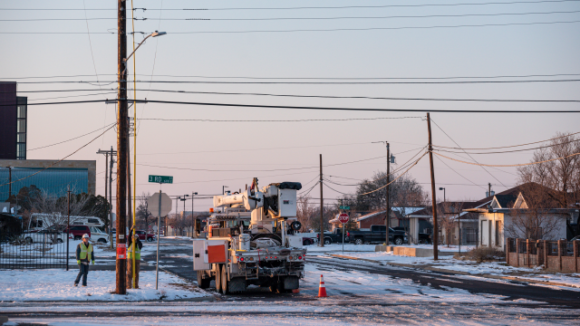While renewable energy sources such as wind turbines and solar panels fuel a fraction of the state’s energy grid, the bulk of Texas’ power is supplied by natural gas, coal and nuclear plants, with natural gas power plants generating nearly half of the state’s electricity, according to the state’s comptroller. No matter the source, however, a lack of winterization was a big factor in the failure of Texas energy producing operations during the historically severe and lengthy freeze that enveloped the state starting in the second week of February and left millions without electricity for days. But it didn’t have to be that way, says one oil and gas insurance and risk management expert.
“Winterization is protecting the equipment and the instrumentation, so it won’t be susceptible to failure from cold weather much like they do in Canada or North Dakota or any place with cold weather. That just wasn’t in place in Texas,” said David Robertson, Global Head of Energy Risk Consulting at Allianz Global Corporate & Specialty.
With natural gas, for example, the problems start at the wellhead, Robertson said. “Texas has so much gas that they don’t have a lot of online storage. It’s in the ground when they need it. They just open the valve a little bit more and take out more and it connects directly into the entire system.
“Well, the cold weather impacts gas, the well itself, the instrumentation, it impacts the pipelines somewhat. Even natural gas pipelines are sensitive to cold weather, especially if the cold weather is severe and extended.”
During Texas’ recent big freeze, diminished gas production at the wellhead created a domino effect — reduced supply to natural gas plants meant utilities couldn’t produce enough electricity to keep up with demand. As the temperature dropped people across the state turned up the heat in their homes and businesses, but electrical generating plants weren’t getting enough fuel to respond to the surge.
Generating facilities “also suffered from the same issue of not being well winterized. So, their equipment began to fail. Instrumentation, utility lines, things like that, freezing up, not working right. So, not only did they not have enough gas to run, but they started to suffer from their own inability to run at full speed, just because their own equipment wasn’t working well in cold weather,” Robertson said.
As an energy risk consultant, it’s Robertson’s job and that of his team of engineers to analyze the risks in energy production facilities whether it’s the oil and gas exploration and production — or upstream — operations, the midstream raw material transportation systems and storage facilities, or the downstream petrochemical plants.
“We go out and see the facilities, we meet the senior management, we spend some time touring the facilities with the people who work there, and we develop a feel, a picture of how they do their business and how safely they do it relative to their peers,” Robertson said.
It’s complicated without strong regulations in place like they have in Europe where companies are required to meet certain clearly defined standards, he said. “In our world, it’s not so clear. … We go out and we meet with our insureds and we tour their facilities, and we meet their management. And if we do see opportunities for them to improve, we try to sell our ideas to them and convince them that it’s in their best interest to do it themselves.”
However, Robertson added, it is “incumbent upon the business owners to make the changes, to make the investments.”
Robertson said he and his team try to help make “the world a safer place” by working with insureds to identify risks and educate clients on “best practices or ways to mitigate those risks. And in this case, it’s just probably better implementation of winterization practices.”
For example, “on the renewable end, the windmills, turbines, have winterization packages. There are kits that you can install that will de-ice the blades, that will keep the motors and the gearboxes warm and running. They run really well in Scandinavia, and Canada, and Northern United States,” he said.
Those winterization packages apparently weren’t installed on many turbines in Texas, but it’s “pretty clear that it wouldn’t have been a bad investment,” he said.
Similarly, there are options for winterizing oil and gas operations at every point from upstream to downstream, Robertson said. He used as an example North Dakota, which is now one of the top states for oil and gas production and is well equipped to handle extended and extreme cold weather. While some parts of North Dakota experienced controlled rolling blackouts during the recent record low temperatures, it avoided the intense and widespread energy disruption that plagued Texas, according to various local media reports.
“So, it’s just a matter of … I mean, I hate to say it, spending the money on the installation and maintenance of winterization, whether it’s insulation, trace heating, building enclosures to take stuff out of the weather, things like that.” He added that his group at Allianz utilizes “winterization checklists that we share with our insureds to help them.”
About the photo: An Oncor Electric Delivery crew works on restoring power to a neighborhood following the winter storm that passed through Texas Thursday, Feb. 18, 2021, in Odessa, Texas. (Eli Hartman/Odessa American via AP)
Topics Texas
Was this article valuable?
Here are more articles you may enjoy.



 Good Times for US P/C Insurers May Not Last; Auto Challenges Ahead
Good Times for US P/C Insurers May Not Last; Auto Challenges Ahead  Georgia Republicans Move to Scrap State Income Tax by 2032 Despite Concerns
Georgia Republicans Move to Scrap State Income Tax by 2032 Despite Concerns  SIAA Announces Strategic Partnership With Progressive
SIAA Announces Strategic Partnership With Progressive  Nearly Half of 100 Largest P/C Insurers Destroy Value: ACORD
Nearly Half of 100 Largest P/C Insurers Destroy Value: ACORD 

